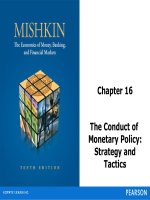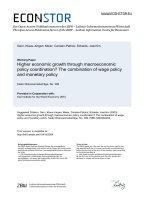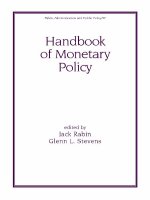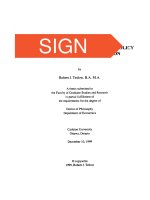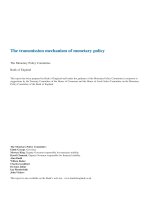tools of monetary policy
Bạn đang xem bản rút gọn của tài liệu. Xem và tải ngay bản đầy đủ của tài liệu tại đây (550 KB, 45 trang )
Copyright 2011
Pearson Canada Inc.
17
- 1
Chapter 17
Tools of Monetary Policy
Copyright 2011
Pearson Canada Inc.
17
- 2
The Large Value Transfer System (LVTS) I
•
The LVTS (introduced in 1999)
–
electronic, real-time net settlement network
–
designed to provide immediate finality and
settlement to time-critical transactions
•
LVTS participants know in real time their large-
value, wholesale transactions (over $50,000).
•
Transactions account for < 1% of the total
number of transactions
•
They make up 94% of the value of transactions
in Canada
Copyright 2011
Pearson Canada Inc.
17
- 3
The Large Value Transfer System (LVTS) II
•
The LVTS uses multilateral netting — only the
net credit or debit position of each participant
vis-à-vis all other participants is calculated for
settlement
Copyright 2011
Pearson Canada Inc.
17
- 4
Systemic Risk
•
The LVTS has been put in place to eliminate
systemic risk. In fact, participants can make a
payment only if:
•
they have positive settlement balances in their
accounts with the Bank of Canada,
•
posted collateral (such as T-bills and bonds), or
•
explicit lines of credit with other LVTS participants
Copyright 2011
Pearson Canada Inc.
17
- 5
Non-LVTS Transactions
•
These are non-LVTS (paper-based) payment items,
such as cheques
•
These items are cleared through the Automated
Clearing Settlement System (ACSS), an electronic
payments system also operated by the CPA
•
The ACSS aggregates interbank payments and
calculates the net amounts to be transferred from
and to each participant's settlement account with
the Bank of Canada
•
Direct Clearers are subset of LVTS participants who
participate directly in the ACSS
Copyright 2011
Pearson Canada Inc.
17
- 6
The Operating Band for the Overnight
Interest Rate I
•
The interest rate at which participants borrow
and lend overnight funds to each other is
known as the overnight interest rate
•
The Bank of Canada implements monetary
policy by changing the overnight interest rate.
•
Such changes influence other short-term
interest rates and the exchange rate
Copyright 2011
Pearson Canada Inc.
17
- 7
The Operating Band for the Overnight
Interest Rate II
•
The Bank’s objective is to keep the overnight
rate within a band of 50 basis points
•
Since December 2000, the Bank operates
under a system of eight “fixed” dates
throughout the year for announcing changes to
the operating band
Copyright 2011
Pearson Canada Inc.
17
- 8
The Operating Band for the Overnight
Interest Rate III
Copyright 2011
Pearson Canada Inc.
17
- 9
The Bank’s Standing Liquidity Facilities I
•
At the end of each day, each LVTS participant must
bring its settlement balance with the Bank close to
zero.
•
The Bank therefore stands ready (standing facilities)
to provide or absorb liquidity with an overnight
duration to participants facing unforeseen liquidity
shocks.
Copyright 2011
Pearson Canada Inc.
17
- 10
The Bank’s Standing Liquidity Facilities II
•
The initiative is on the side of the LVTS participant. A
participant may use the Bank’s lending facility to
obtain (against eligible collateral) overnight liquidity in
case of a shortage, or it may use the deposit facility to
make deposits in case of excess liquidity.
Copyright 2011
Pearson Canada Inc.
17
- 11
The Bank of Canada and the Operating band
•
If the overnight rate increases toward the upper limit
of the operating band, then the Bank will lend at the
bank rate to put a ceiling on the overnight rate
•
If the overnight rate falls toward the lower limit of the
operating band, then the Bank will accept deposits
from LVTS participants at the bank rate less 50 basis
points – putting a floor on the overnight rate
Copyright 2011
Pearson Canada Inc.
17
- 12
The Bank of Canada and the Operating band
•
If the overnight rate increases toward the upper limit
of the operating band, then the Bank will lend at the
bank rate to put a ceiling on the overnight rate
•
If the overnight rate falls toward the lower limit of the
operating band, then the Bank will accept deposits
from LVTS participants at the bank rate less 50 basis
points – putting a floor on the overnight rate
Copyright 2011
Pearson Canada Inc.
17
- 13
The Channel/Corridor System for the Overnight Rate
Copyright 2011
Pearson Canada Inc.
17
- 14
Demand for Reserves
•
Demand Curve
–
As the overnight interest rate decreases the
opportunity cost of holding desired reserves falls
and ceteris paribus, the quantity of reserves
demanded rises.
–
Rd slopes downward
Copyright 2011
Pearson Canada Inc.
17
- 15
Supply Curve for Reserves
•
Supply Curve
–
quantity of reserves supplied is infinitely elastic at i
b
–
Also flat at i
b
-0.50 because banks would not ledn in
the overnight market
–
Between i
b
-0.50 and ib, banks will not borrow from
the Bank and borrowed reserves (BR) equal zero
(cheaper to borrow in overnight market)
Copyright 2011
Pearson Canada Inc.
17
- 16
The Channel/Corridor System for the Overnight Rate
•
In terms of Figure 17-2, the equilibrium
interest rate will always be within the
operating band
•
The system enables the Bank to keep the
overnight interest rate in the narrow
channel/corridor with an upper limit of i
b
and a
lower limit of i
b
- 0.50
Copyright 2011
Pearson Canada Inc.
17
- 17
How Monetary Policy Affects the Economy I
Copyright 2011
Pearson Canada Inc.
17
- 18
How Monetary Policy Affects the Economy II
•
Changes in the overnight rate influences other
interest rates and the exchange rate
•
The level of short term interest rates and the
exchange rate of the Canadian dollar
determine the monetary conditions in which
the economy operates
Copyright 2011
Pearson Canada Inc.
17
- 19
How Monetary Policy Affects the Economy III
Copyright 2011
Pearson Canada Inc.
17
- 20
How Monetary Policy Affects the Economy IV
Copyright 2011
Pearson Canada Inc.
17
- 21
Nominal Interest Rates and Monetary Policy
•
Bank of Canada uses nominal overnight
interest rate as operating instrument
•
Effects on the monetary policy on economic
activity are from the real interest rate affecting
consumption and investment
•
Short term nominal rates affect short and long-
term real interest rates under assumption of
sticky prices
Copyright 2011
Pearson Canada Inc.
17
- 22
Open Market Operations I
•
Open market operations relate to the Bank of
Canada selling/buying government bonds
•
Open market purchases expand bank reserves
and the monetary base, lowering interest rates
and raising the money supply
•
Open market sales reduce bank reserves and the
monetary base, increasing interest rates and
reducing the money supply
Copyright 2011
Pearson Canada Inc.
17
- 23
Open Market Operations II
•
Two Types
1. Dynamic:
Meant to change MB
2. Defensive:
Meant to offset other factors affecting MB
The Bank conducts open market operations on
government bills and bonds as the market for
these instruments is most liquid and have the
largest trading volume
Copyright 2011
Pearson Canada Inc.
17
- 24
SPRAs and SRAs I
•
In 1985, the Bank introduced repos, which in Canada
are known as Special Purchase and Resale Agreements
(SPRAs)
•
In 1986, the Bank introduced reverse repos, known in
Canada as Sale and Repurchase Agreements (SRAs)
•
By 1994, the Bank stopped conducting open market
operations in government of Canada T-bills and bonds
and its most common operations since then have been
repurchase transactions, either SPRAs of SRAs.
Copyright 2011
Pearson Canada Inc.
17
- 25
SPRAs and SRAs II
•
Special Purchase and Resale Agreements (SPRAs) are a
tool to reduce undesired upward pressure on the
overnight rate
•
Sale and Repurchase Agreements (SRAs) are a tool to
reduce undesired downward pressure on the overnight
rate
•
SPRAs and SRAs are conducted with primary dealers
(formerly known as jobbers) the Big Six and the
major investment dealers.
